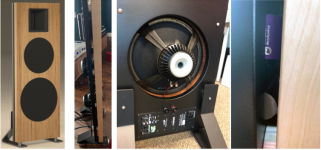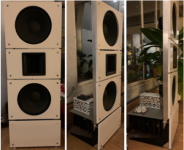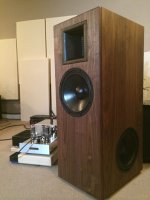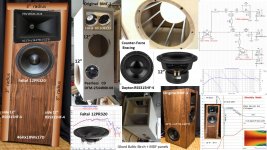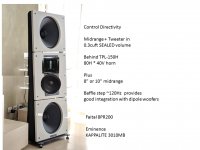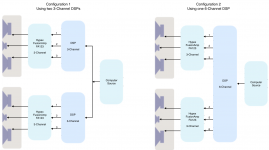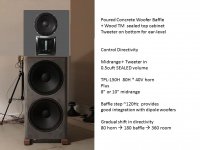A few years ago I pressed a pair of old Pass A40 stereo amps into service again. I bridged them so I had a pair of mono amps and fitted them into the base of an open baffle speaker project based on the Pure Audio Projects Trio15 Beyma TPL-150H.
I've attached a file with a few snaps of an early stage of the project.
I've grown very fond of these speakers, but I fear my aged A40s will rapidly approach the end of their useful life.
As such I've started to think about replacing the A40s and I thought I'd take the occasion to rework the speakers too.
I came across the Spatial Audio X3s . See 1st attachment.
It strikes me that Spatial has designed a form factor for open baffle speaker, that one might readily adapt to a DIY speaker project.
You can see from the attached snaps that the speaker appears to have 2 baffles. The front one (wood colored) mounts the drivers and a second described on Spatial's website as:
I'd like to replicate something like these speakers (at least visually) using the drivers I currently have, so...
Does anyone have any thoughts on how to "isolate" the "secondary sub-baffle" and what material to make it from?
In what I've begun to imagine, I think I would use three amps per speaker and digital crossovers. I think this would provide a great deal of design flexibility.
Finding room to mount all of this will likely take some ingenuity. I do like the idea of having all the components mounted in the monolithic double baffles and the baffles supported by a simple stand. My wife, an architect with minimalist sensibilities would prefer such a design.
Any recommendations on how to go about this appreciated.
I've attached a file with a few snaps of an early stage of the project.
I've grown very fond of these speakers, but I fear my aged A40s will rapidly approach the end of their useful life.
As such I've started to think about replacing the A40s and I thought I'd take the occasion to rework the speakers too.
I came across the Spatial Audio X3s . See 1st attachment.
It strikes me that Spatial has designed a form factor for open baffle speaker, that one might readily adapt to a DIY speaker project.
You can see from the attached snaps that the speaker appears to have 2 baffles. The front one (wood colored) mounts the drivers and a second described on Spatial's website as:
"A secondary sub-baffle provides resonance draining properties and houses the isolated mid/high passive crossover and integrated N-Core power amplifier which drives the subwoofer.
I'd like to replicate something like these speakers (at least visually) using the drivers I currently have, so...
Does anyone have any thoughts on how to "isolate" the "secondary sub-baffle" and what material to make it from?
In what I've begun to imagine, I think I would use three amps per speaker and digital crossovers. I think this would provide a great deal of design flexibility.
Finding room to mount all of this will likely take some ingenuity. I do like the idea of having all the components mounted in the monolithic double baffles and the baffles supported by a simple stand. My wife, an architect with minimalist sensibilities would prefer such a design.
Any recommendations on how to go about this appreciated.
Attachments
The BMF-1 speaker custom-built by Tweek Geek Colorado audio Boutique has received high praise in public shows. The use of two-sealed, near-floor, side-side, counter-force, DSP-controlled woofers provides powerful deep bass in a medium size 6cuft cabinet. The BMF-1 stands 43”high x 16”wide x 20”deep. The Tweek Geek website has several construction pictures,
You would need to purchase 12" midranges like the $230 Faital 12PR320, or if cost is an issue the $130 Eminence DeltaPro 12A, and an electronic crossover plus high power bass amp to drive two of your 15" woofers in a sealed and bass-equalized bottom cabinet section.
ASSUMPTIONS:
1) Great sound is more important than having the 2001 Monolith in your living room.
2) You own TPL-150H and four 15" Eminence woofers.
3) The controlled directivity generated by the TPL-150H horn tweeter is the key sonic signature.
4) You and your wife can customize the final shape, dimensions, and finish.
-Equal volume from tall and shallow cabinet?
-Plywood? Black? White?
-Large radius edge cuts? (1.5" radius router bit ~$130)
---Monolith or "big rounds JukeBox"
You would need to purchase 12" midranges like the $230 Faital 12PR320, or if cost is an issue the $130 Eminence DeltaPro 12A, and an electronic crossover plus high power bass amp to drive two of your 15" woofers in a sealed and bass-equalized bottom cabinet section.
ASSUMPTIONS:
1) Great sound is more important than having the 2001 Monolith in your living room.
2) You own TPL-150H and four 15" Eminence woofers.
3) The controlled directivity generated by the TPL-150H horn tweeter is the key sonic signature.
4) You and your wife can customize the final shape, dimensions, and finish.
-Equal volume from tall and shallow cabinet?
-Plywood? Black? White?
-Large radius edge cuts? (1.5" radius router bit ~$130)
---Monolith or "big rounds JukeBox"
Attachments
@LineSource --
Thanks for your input. Like some others in these forums, I have a particular interest in Open Baffle design. As stated in my opening post:
I see this as an incremental improvement to the speakers and components I already have rather than a completely new ground up build.
Everything has tradeoffs. For what I want to try to build I seek:
Also, and something I ought to have specifically requested...
Recommendations on digital crossovers and plate amplifiers that would make sense for what I have described.
I will check the BMF-1 speaker info to see what they use for DSP. It could prove a useful source of information.
P.S. -- Can anyone recommend a digital crossover discussion on this forum to better familiarize myself?
Thanks for your input. Like some others in these forums, I have a particular interest in Open Baffle design. As stated in my opening post:
I'd like to replicate something like these speakers (at least visually) using the drivers I currently have
I see this as an incremental improvement to the speakers and components I already have rather than a completely new ground up build.
Everything has tradeoffs. For what I want to try to build I seek:
...thoughts on how to "isolate" the "secondary sub-baffle" and what material to make it from...
Also, and something I ought to have specifically requested...
Recommendations on digital crossovers and plate amplifiers that would make sense for what I have described.
I will check the BMF-1 speaker info to see what they use for DSP. It could prove a useful source of information.
P.S. -- Can anyone recommend a digital crossover discussion on this forum to better familiarize myself?
If you want to rework the speakers and get better sound, I posted some design ideas in this post:
https://www.diyaudio.com/forums/multi-way/320815-multi-ob-2.html#post5389471
As you can see the PAP style and other large OB speakers don't follow this design philosophy. I think they have built in some flaws as a result, but the speakers look very attractive and impressive and that is what many "audiophiles" seem to value in their gear as much as or even more than the actual performance.
https://www.diyaudio.com/forums/multi-way/320815-multi-ob-2.html#post5389471
As you can see the PAP style and other large OB speakers don't follow this design philosophy. I think they have built in some flaws as a result, but the speakers look very attractive and impressive and that is what many "audiophiles" seem to value in their gear as much as or even more than the actual performance.
I imagine that the founder of Spatial Audio and Emerald Acoustics frequents this forum.
If he does, he's probably making the baffle out of a constrained-layer-damping composite.
There's a number of threads on here about how to do it.
On a side note, I've heard both and they sound really nice.
If he does, he's probably making the baffle out of a constrained-layer-damping composite.
There's a number of threads on here about how to do it.
On a side note, I've heard both and they sound really nice.
Baseball allows 3-strikes. Here is my second controlled directiviy pitch....
Sealed 0.5cuft TM cabinet between the Top and Bottom dipole woofers.
=====
The soundstage changes created from a crossover between a monopole 80H x 40V horn loaded tweeter directly to a large diameter dipole driver will be noticed by most listeners.
A 0.5cuft sealed box tweeter-midrange cabinet using the TPL-150H crossed at 1800Hz to the 8" Faital 8PR200-8 crossed at the 120Hz baffle step frequency to the dipole woofers provides a more gradual change from 180-degree monopole baffle to 360-degree full room directivity
Sealed 0.5cuft TM cabinet between the Top and Bottom dipole woofers.
=====
The soundstage changes created from a crossover between a monopole 80H x 40V horn loaded tweeter directly to a large diameter dipole driver will be noticed by most listeners.
A 0.5cuft sealed box tweeter-midrange cabinet using the TPL-150H crossed at 1800Hz to the 8" Faital 8PR200-8 crossed at the 120Hz baffle step frequency to the dipole woofers provides a more gradual change from 180-degree monopole baffle to 360-degree full room directivity
Attachments
It's difficult to see clearly just how the 2 panels are mounted together. The first panel is obviously similar to multiple stacked BB plywood, which has rigidity advantages but a bit of a pain to make. The second could be anything, but the big question to me is how the two panels connect together. My guess is the front baffle has to have a firm secure mechanical connection to the metal feet/stand. That suggests the 2nd panel could be decoupled?, despite the look of the shiny metal disc connectors between them -- and perhaps it is some kind of internally well-damped panel. The simplest effective rigid damped composite panel a DIYer can make is to bond two layers of relatively thin (say 9mm?) BB ply with Green Glue -- the acoustic damping goop which also doubles as glue. It does work...."isolate" the "secondary sub-baffle" and what material to make it from...
Relatively cheap and simple to try.
Whether you'll hear any real improvement depends, most likely, on how much panel vibration is affecting the performance of your current setup -- and how much reduction of such vibration the new arrangement provides. Assuming you keep the panel/driver arrangement otherwise the same. You might want to invest in a vibrometer to get some empirical evidence one way or the other.
Personally, I'm not convinced a secondary panel like that is necessary for either a vibration sink or to house electronics. The old right-angle ledge on the back bottom of the speaker like on so many electrostatics etc seems a fine place for such things. And I'd be more interested in using a constrained damped layer panel as the baffle rather than try to pull vibrational energy out of it after it's already been "excited". Just my 2 cents.
The simplest way to do this is a Hypex FusionAmp FA123 or similar 3 ch + DSP plate amp per spkr. When implemented, it should at least match your current amp + passive xover setup and likely far exceed it.three amps per speaker and digital crossovers
@silent_mike
The Spatial Audio website states this. Good observation.
My wife, an architect, may have access to sheets of this material.
Seems like a number of possible ways to do this, but it gets tricky because one would still need to have the ability to disassemble the speakers to change or tinker with drivers and cables.
Interesting. I'd love to get an up close look of how Spatial does this.
That can work. Thanks.
I do have another option for non-resonant material. My wife's architecture firm (with some wait time) can often get Corian from her construction sites where a contractor has miss-cut a counter top. We've cut down some of these pieces and used them for smaller counter tops in our home.
With a little luck, I could get enough Corian for two baffles for each speaker.
This would still run into the issue of decoupling, but might work pretty well. Thoughts?
Certainly the most logical and obvious. In such a configuration, it seems like I'd still benefit from some kind of decoupling of the amps and DSPs. Any thoughts?
I had just started to look at the
Although I may have missed something, Hypex does not appear to have a DSP available to DIYs anymore. Any suggestions? miniDSP has a number of options. Guidance appreciated.
A few additional questions for any takers.
The attached image shows my thoughts on two possible configurations for my system. Note, I use only computer source audio. The computer I use currently connects via an optical cable to a DAC that has a volume control. The DAC then to my current speakers.
In the attached image, Configuration 1 imagines using a 3-channel DSP for each speaker. Configuration 2 imagines using a 6-channel DSP that supports both speakers.
Configuration 1 (if it can work) would leave me with an audio system (at least visually, keeping my partner in consideration...) with only two speakers connected to a computer -- minimalist appearance (with hidden complexity).
Would Configuration 1 work? If it does, how do I connect the computer to the two DSPs? Two USB cables? Can I split the optical output from the computer?
Its the details that get you.
Thoughts appreciated.
"...The first panel is obviously similar to multiple stacked BB plywood..."
The Spatial Audio website states this. Good observation.
My wife, an architect, may have access to sheets of this material.
"...the big question to me is how the two panels connect together."
Seems like a number of possible ways to do this, but it gets tricky because one would still need to have the ability to disassemble the speakers to change or tinker with drivers and cables.
"My guess is the front baffle has to have a firm secure mechanical connection to the metal feet/stand. That suggests the 2nd panel could be decoupled?..."
Interesting. I'd love to get an up close look of how Spatial does this.
"The simplest effective rigid damped composite panel a DIYer can make is to bond two layers of relatively thin (say 9mm?) BB ply with Green Glue -- the acoustic damping goop which also doubles as glue."
That can work. Thanks.
I do have another option for non-resonant material. My wife's architecture firm (with some wait time) can often get Corian from her construction sites where a contractor has miss-cut a counter top. We've cut down some of these pieces and used them for smaller counter tops in our home.
With a little luck, I could get enough Corian for two baffles for each speaker.
This would still run into the issue of decoupling, but might work pretty well. Thoughts?
"The old right-angle ledge on the back bottom of the speaker like on so many electrostatics etc seems a fine place for such things. "
Certainly the most logical and obvious. In such a configuration, it seems like I'd still benefit from some kind of decoupling of the amps and DSPs. Any thoughts?
I had just started to look at the
plate amp you recommended. It seems like a great fit for the project. Thanks."...Hypex FusionAmp FA123..."
Although I may have missed something, Hypex does not appear to have a DSP available to DIYs anymore. Any suggestions? miniDSP has a number of options. Guidance appreciated.
A few additional questions for any takers.
The attached image shows my thoughts on two possible configurations for my system. Note, I use only computer source audio. The computer I use currently connects via an optical cable to a DAC that has a volume control. The DAC then to my current speakers.
In the attached image, Configuration 1 imagines using a 3-channel DSP for each speaker. Configuration 2 imagines using a 6-channel DSP that supports both speakers.
Configuration 1 (if it can work) would leave me with an audio system (at least visually, keeping my partner in consideration...) with only two speakers connected to a computer -- minimalist appearance (with hidden complexity).
Would Configuration 1 work? If it does, how do I connect the computer to the two DSPs? Two USB cables? Can I split the optical output from the computer?
Its the details that get you.
Thoughts appreciated.
Attachments
Hypex FA123 boards have built-in 3 channel dsp and amps. GUI is a bit tricky.
Hypex Electronics B.V.
The New Hypex Fusion Plate amps
Hypex Electronics B.V.
The New Hypex Fusion Plate amps
@Juhazi --
That simplifies things. The build becomes very straightforward indeed! A little GUI trickiness seems like a small price to pay.
Many thanks for clarifying this.
So how do I deliver my computer source to each plate amplifier?
The link to The New Hypex Fusion Plate amps discussion has 198 pages (seems like these plate amps merit the attention). Any direction to a specific discussion of connecting my computer appreciated.
I recognize I may have simply overlooked something obvious.
Hypex FA123 boards have built-in 3 channel dsp and amps. GUI is a bit tricky.
That simplifies things. The build becomes very straightforward indeed! A little GUI trickiness seems like a small price to pay.
Many thanks for clarifying this.
So how do I deliver my computer source to each plate amplifier?
The link to The New Hypex Fusion Plate amps discussion has 198 pages (seems like these plate amps merit the attention). Any direction to a specific discussion of connecting my computer appreciated.
I recognize I may have simply overlooked something obvious.
Corian would not be my first choice; there've been posts elsewhere on this forum that it is more resonant than you would think. Not having worked with it first hand, I don't know for sure. It might be worth a try -- just about anything braced well enough becomes rigid.I do have another option for non-resonant material. My wife's architecture firm (with some wait time) can often get Corian from her construction sites where a contractor has miss-cut a counter top. We've cut down some of these pieces and used them for smaller counter tops in our home.
With a little luck, I could get enough Corian for two baffles for each speaker.
This would still run into the issue of decoupling, but might work pretty well. Thoughts?
BTW, I was only conjecturing that the second panel is decoupled. Maybe it's firmly connected in order for its internal damping to act as the "vibration sink". You might have to get an up close & personal look at the Spatial Audio spkr. Maybe there's a video on youtube that shows fine details?
Actually, I think the better option is to create a really well damped but still rigid main baffle. This has the benefit of stopping the vibrations right where they start at the drivers rather then let them propagate into the panel, which then have to be suppressed. I've been thinking about a 2 ply 9mm or 12mm BB with Green Glue between them, and the drivers mounted only on the outside layer of plywood, not allowing the driver mounting bolts to squeeze the 2 boards any tighter, to avoid mechanical short circuit. The idea is that the GG damping layer absorbs the vibrations, and the back plywood layer adds stiffness without picking up the vibrations from the front board.
If I was doing it, I'd use some kind of solid frame -- hardwood, BB, metal tubing (internally damped with expanding foam) whatever -- as a floor base for the speaker frame, but extended long enough behind the speaker to house the amps etc. That housing could be decoupled from the base with silicone rubber, sorbothane or other elasto-visco damping sleeves, plugs, etc. Similar to what's used for compliant turntable suspensions, if need be, though I doubt the housing needs to float like a Linn LP12. Your wife probably knows architectural materials that can be used.Certainly the most logical and obvious. In such a configuration, it seems like I'd still benefit from some kind of decoupling of the amps and DSPs. Any thoughts?
You know the FA123 has DSP built in?! External DSP is not necessary. You only need to multiply the optical output at your PC to run one to each speaker. And if you use phono plug/wire SPDIF, the FA123s have pass-through output which means you can run one cable from PC to one speaker, then daisy chain from that spkr to the other.Configuration 1 (if it can work) would leave me with an audio system (at least visually, keeping my partner in consideration...) with only two speakers connected to a computer -- minimalist appearance (with hidden complexity).
Would Configuration 1 work? If it does, how do I connect the computer to the two DSPs? Two USB cables? Can I split the optical output from the computer?
@silent_mike
Brilliant. Every mystery revealed!
I'll start with the pair of FA123s to replace my beloved A40s. (hmmm....? I may yet get some more life out of them with my mini home theater alcove).
I can discretely fasten the FA123s to the speaker stand with dampening in mind.
I already have very rigid and I think a pretty non-resonant vertical frame supporting my current baffles - 2" aluminum tubing with 1/4" walls into which I hammered wooden 2 x 2s. I thought to spay in dense urethane foam, but it the wood inside the aluminum has served me pretty well so far (although I expect forum members may have multiple suggestions on this).
With the new amplification & DSP up and running, I'll explore replacing my existing front baffles or even those aluminum verticals.
I'll post pics as things progress.
Many many thanks to you and all other participant.
Brilliant. Every mystery revealed!
I'll start with the pair of FA123s to replace my beloved A40s. (hmmm....? I may yet get some more life out of them with my mini home theater alcove).
I can discretely fasten the FA123s to the speaker stand with dampening in mind.
I already have very rigid and I think a pretty non-resonant vertical frame supporting my current baffles - 2" aluminum tubing with 1/4" walls into which I hammered wooden 2 x 2s. I thought to spay in dense urethane foam, but it the wood inside the aluminum has served me pretty well so far (although I expect forum members may have multiple suggestions on this).
With the new amplification & DSP up and running, I'll explore replacing my existing front baffles or even those aluminum verticals.
I'll post pics as things progress.
Many many thanks to you and all other participant.
All that matters from a sonic point of view is that the baffle doesn't resonate, vibrations per se don't matter if they are small and spread across the spectrum.
FA board can be fed with digital or analog input.
If source is digital, one plate is "master" that gets the signal, and is configured as L or R. Then just connecct a digital cable from it to the other and configure it as slave. So - this applies only to stereo signal splitting. Multichannel gets more tricky...
I use analog RCA feed from my HT amp, each FA unit is "master"
---
Like Scott, I can't see big/worthwhile advantage of a sandwich open baffle. There are so many more much much more difficult issues to solve!
Baflle size is a very important factor to make a full range dipole working. It is easy to make the midrange sub-baffle narrower.
Dipolplus - Alles über offene Schallwände
Tech
Electro-acoustic models
If source is digital, one plate is "master" that gets the signal, and is configured as L or R. Then just connecct a digital cable from it to the other and configure it as slave. So - this applies only to stereo signal splitting. Multichannel gets more tricky...
I use analog RCA feed from my HT amp, each FA unit is "master"
---
Like Scott, I can't see big/worthwhile advantage of a sandwich open baffle. There are so many more much much more difficult issues to solve!
Baflle size is a very important factor to make a full range dipole working. It is easy to make the midrange sub-baffle narrower.
Dipolplus - Alles über offene Schallwände
Tech
Electro-acoustic models
Last edited:
Baseball allows 3-strikes. Here is my third controlled directiviy pitch....
-----------------------------
Are your investments directed to Music Magic, or Architectural Style ?
We have 350-lb Apogee Full Range LineSource dipole speakers in our living room
---all analog with Krell crossovers and amps.
-We added several Fichus trees behind them for diffusion, BIG improvement.
-We added poly-fill screens to walls 10-feet behind our listening sofa to absorb reflections. BIG improvement.
For Music Magic, dipoles require extensive room treatment.
For Music Magic modern controlled directivity horn speakers create an excellent soundstage in ordinary rooms with modest room treatment. (my first strike BMF_1 design). --HORN KEY: keep the listener several feet away from the (rear)walls.
--------------------
Some listeners like the accurate imaging that high directivity speakers give. (you are there)
Some listeners like a controlled BUT diffuse soundfield that surrounds them. (they are here)
========3-strikes AMEN==============
Poured concrete has been used for dipole baffles.
You could put a sealed 0.5 cuft Mid-Tweet wood cabinet on top of two 15" dipole woofers. The tweeter would be on the cabinet bottom to match 36"-39" seated ear level. Because of the low ~120Hz crossover frequency to the dipole woofers, a top midrange will integrate well with bottom woofers.
Are your investments directed to Music Magic, or Architectural Style ?
-----------------------------
Are your investments directed to Music Magic, or Architectural Style ?
We have 350-lb Apogee Full Range LineSource dipole speakers in our living room
---all analog with Krell crossovers and amps.
-We added several Fichus trees behind them for diffusion, BIG improvement.
-We added poly-fill screens to walls 10-feet behind our listening sofa to absorb reflections. BIG improvement.
For Music Magic, dipoles require extensive room treatment.
For Music Magic modern controlled directivity horn speakers create an excellent soundstage in ordinary rooms with modest room treatment. (my first strike BMF_1 design). --HORN KEY: keep the listener several feet away from the (rear)walls.
--------------------
Some listeners like the accurate imaging that high directivity speakers give. (you are there)
Some listeners like a controlled BUT diffuse soundfield that surrounds them. (they are here)
========3-strikes AMEN==============
Poured concrete has been used for dipole baffles.
You could put a sealed 0.5 cuft Mid-Tweet wood cabinet on top of two 15" dipole woofers. The tweeter would be on the cabinet bottom to match 36"-39" seated ear level. Because of the low ~120Hz crossover frequency to the dipole woofers, a top midrange will integrate well with bottom woofers.
Are your investments directed to Music Magic, or Architectural Style ?
Attachments
This morning I ordered a pair of FA123s from Madisound.
They advised me I could download the configuration software.
Afterwords, I found some confusing information about the software required to configure the FA123s.
See: Hypex Filter Design
It looks like this software only works with Windows and costs 1,000 Euro!
This seems far out of line.
But...the Fusion Amp User Guide says:
Maybe the amps come with basic software and you can buy more advanced?
Have I looked at the right thing?
Do the amps come with configuration software to set up the DSPs?
Does software exist for DIYers?
How does one actually do this?
1,000 Euro + getting or borrowing a Windows computer just feels wrong.
Thoughts appreciated.
They advised me I could download the configuration software.
Afterwords, I found some confusing information about the software required to configure the FA123s.
See: Hypex Filter Design
It looks like this software only works with Windows and costs 1,000 Euro!
This seems far out of line.
But...the Fusion Amp User Guide says:
Hypex Filter Design (HFD)
HFD is a free software tool needed to configure the FusionAmp. To protect your valuable drivers, the DSP does not contain a filter out of the box. A filter needs to be configured and uploaded before the FusionAmp will produce an output signal.
Maybe the amps come with basic software and you can buy more advanced?
Have I looked at the right thing?
Do the amps come with configuration software to set up the DSPs?
Does software exist for DIYers?
How does one actually do this?
1,000 Euro + getting or borrowing a Windows computer just feels wrong.
Thoughts appreciated.
Last edited:
- Home
- Loudspeakers
- Multi-Way
- Open baffle form factor questions
